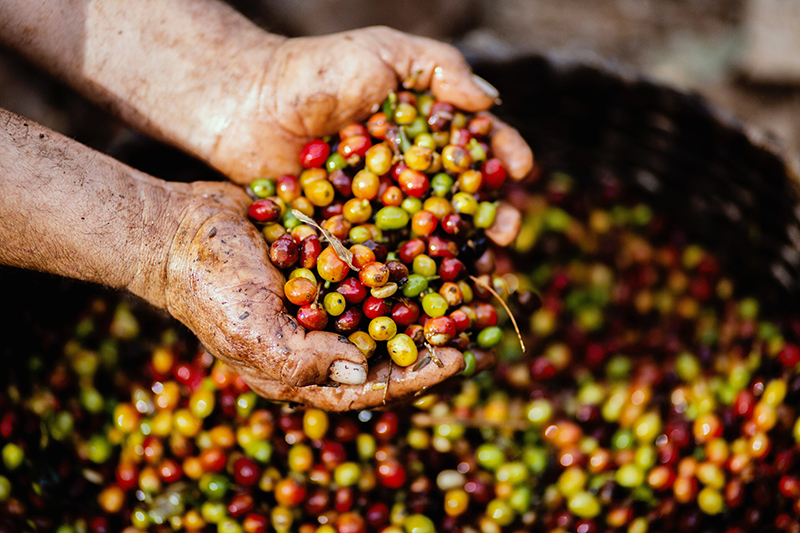We put our heads together and collectively pooled our caffeined knowledge in order to spill the beans about some of the most interesting coffee facts around the world. We searched far and near, scoured countless websites and books, and watched at least two YouTube videos to bring you the exhaustible list you’re about to read.
So grind those beans and turn on the kettle, you’re going to need something hot, strong and caffeinated for this long list of coffee facts and figures.

General Coffee Facts
- Coffee wasn’t always consumed as a beverage. In fact, according to some historians, the first tribes to consume coffee ground the berries together, added animal fat and chewed on them for energy.
- Instant coffee has been around for as long as 250 years. The first instant coffee showed up in England around 1771, but wouldn’t be patented in the US until over 130 years later.
- There have been several attempts to ban coffee as a beverage. Apparently it encouraged “radical thinking” and in 1746 Sweden outlawed by coffee and coffee paraphernalia such as mugs and saucers.
- The Guiness World Record for the oldest cat alive is held by a 38-year-old kitty called Creme Puff. It’s long life is attributed to coffee as it drank some every morning of its life (the cat that Creme Puff beat was 34 years old and had the same owner and diet).
- The world’s most expensive coffee is made from animal poop. Kopi Luwak is harvested from the droppings of a small Indonesian weasel after it eats and digests coffee berries.
- Caffeine can kill you – although you would need as much as 70 cups of coffee drunk in quick succession in order to kill someone weighing around 150 pounds.
- In 1932 Brazil couldn’t afford to send its athletes to Los Angeles to compete in the Olympics. The team loaded its ship with coffee and sold it along the way to pay for their journey.
- Coffee companies that produce decaffeinated coffee don’t just get rid of the excess caffeine – they sell it on to soda companies that use it as a main ingredient in their drinks.
The Property of Coffee

- Coffee beans are technically seeds, but are most people call them beans because of their likeness to legumes.
- There are two main types of coffee – Arabica and Robusta. Arabica accounts for around 60% of global coffee production with Robusta making up the other 40%.
- Coffee grounds are powerful exfoliators that can lift dead skin and make skin appear clearer and brighter. It’s for this reason that they’re used in multiple different skin products.
- Coffee is one of the world’s most powerful antioxidants, and has an antioxidant capacity ten times the amount of similar beverages such as tea.
- Coffee’s original name came from the Yemeni word for wine. In Turkey the word was “kahveh” which the Dutch translated to Koffie. It was from this word that the word “Coffee” was derived.
- 100g of coffee contains about 40mg of caffeine, and the average caffeine content of an 8-oz cup of coffee is around 95 mg.
- Widely known for its many health benefits, coffee may help curb certain cancers such as liver, colon, breast, prostate and rectal cancers.
- Depending on the variety, it will take approximately three to four years for a newly grown coffee plant to bear fruit.
Coffee and Health
- Coffee is full of caffeine – a stimulant which increases alertness and staves of mental and physical fatigue.
- Not just used for staying up late and cramming for exams the next day, coffee is also used to medically to prevent Parkinson’s disease, Alzheimer’s disease, dementia, and cognitive decline.
- Due to coffee’s high caffeine content, it’s also used as a fat burner. Caffeine can boost your body’s metabolic rate, making coffee one of the few natural fat burners available.
- Coffee increases your physical performance by stimulating your nervous system, increases adrenaline levels in the blood, and breaking down fat to use as fuel.
- A single cup of coffee contains essential nutrients such as vitamin B2, vitamin B3, vitamin B5, magnesium and potassium.
- Coffee can help stave off a condition called cirrhosis, where the liver is largely replaced by scar tissue. It was found that people who drink 4 or more cups of coffee a day have an 80% lower risk of contracting the disease.
- Coffee can help fight depression. A study by Harvard found that women who drank 4 or more cups of coffee a day had a 20% lower risk of depression.
- For those who consume a standard Western diet, coffee is likely their biggest source of antioxidants, providing more than fruit and vegetables combined.
Coffee Facts About Starbucks

- Starbucks’ founders were two teachers (Jerry Baldwin and Zev Siegl) and a writer (Gordon Bowker) that had attended university together.
- The original names of the store were between “Cargo House” and “Pequod.” Eventually they settled on the name Starbucks, however, as Starbuck was the ship Pequod’s first mate in the famous book Moby Dick.
- Starbucks is the largest coffee retailer in the world, with more than 20,500 locations in over 40 countries throughout the entire world.
- Harold Schultz shifted the business plan from selling coffee beans to brewed coffee when he took over the company. Before 1987 Starbucks sold only roasted coffee beans and coffee brewing equipment.
- The round tables at Starbucks are very carefully designed to make customers feel less lonely and encourage interaction and conversation.
- Between 1987 and 2011, Starbucks opened an average of two stores per day. That’s almost 800 stores per year!
- While the menu at Starbucks may not seem overly large, there are actually over 87,000 possible drink combinations.
- Starbucks’ largest size drink, the Trenta, has a capacity of 916 milliliters. This is slightly bigger than the average human stomach, which has a capacity of 900ml.
US Coffee Consumption
- 64% of American adults consume coffee every day. That’s just less than 210 million people.
- An average American drinks 3.1 cups of coffee per day. That’s less than the recommended maximum amount of coffee which is 4 cups per day.
- Between all of the coffee drinkers in America, they collectively consume about 400 million cups of coffee every day.
- When you add this together this means that Americans drink about 146 billion cups of coffee annually, making America the leading consumers of coffee in the entire world.
- Coffee drinkers in New York consume more than 7 times the amount of coffee as citizens in other states.
- Despite its voracious appetite for anything coffee-related, Hawaii is the only US state that can actually produce coffee owing to its favorable climate.
- The average American worker spends approximately $20 on coffee per week. Regardless of whether this is a latte from Starbucks, beans for a home roast, or freeze-dried instant coffee.
- The annual coffee retail sales in the US are about $5.2 billion, and the US imports about $4 billion worth of coffee each year.
Coffee Facts About China
- Traditionally a tea-drinking culture, coffee is rapidly becoming the go-to drink in China as its middle class expands.
- China’s coffee marketing is expanding at a rate of 4% a year – compared with the rest of the world which only grows at 2% a year.
- Only 15% of coffee is consumed outside of the home and the office, but this number is changing with the growing number of coffee shops.
- This growth has made coffee the second-most sought-after commodity on the planet.
- Starbucks plans to open 3000 new stores in China within the next 10 years.
- China was first exposed to coffee when a French missionary introduced the plant to the fertile Yunnan province in the southwestern region of the country.
- Today the coffee plantations in Yunnan account for more than 90% of China’s coffee supply, with Arabica beans being the main cultivar.
- Drinking coffee is relatively expensive in China with an average cup of coffee costing between 18-40RMB, or 3 – 6USD – the same price as a whole meal.
Coffee Facts About Brazil
- Brazil is the biggest producer of coffee in the world, being responsible for about 30 percent of the planet’s coffee production.
- Brazil has over 290,000 coffee growers and there are about 6.7 million acres of land devoted to coffee production throughout the country.
- Minas Gerais, in the southwestern part of the country, is Brazil’s largest coffee-producing state – with more than 2.5 million acres of coffee plants, just less than half the country’s total coffee harvest.
- But coffee is grown in more than 2000 jurisdictions across 16 states throughout the entire country.
- Coffee beans made up about 10 percent of Brazil’s total commodity exports in 2013.
- The coffee industry provides around 8 million jobs for Brazil – that’s about 3.8% of the population directly related to growing coffee.
- Coffee was introduced in Brazil in 1727 by Lt. Col. Francisco de Mello Palheta. By 1820 coffee had become Brazil’s chief export.
- It’s estimated that more than 98% of Brazillian households consume coffee.
Coffee Facts About Vietnam
- Vietnam is the second largest coffee producer after Brazil, with Robusta coffee accounting for 97 percent of the total coffee harvest.
- Coffee was introduced by the French in 1857, who discovered that the highlands in the center of the country provided optimal growing conditions for the plant.
- Small scale production gave way to plantations, but the growth of this industry was stalled due to the start of the Vietnam War.
- Vietnamese filter coffee utilizes a tiny steel coffee filter called a Phin which sits on top of a glass and allows coffee to filter down.
- Due to a shortage of milk in the early 20th century, condensed milk was used as a substitute. Because of this, most variations of the drink within Vietnam are incredibly sweet.
- Vietnam’s most popular drink is called cà phê đá – filter coffee served over ice and condensed milk.
- Perhaps the strangest drink in Vietnam is called egg coffee, and it’s exactly what it sounds like. Sugar, coffee and eggs are all whipped together for a delicious drink with the consistency of marshmallow.
- Only 10 percent of Vietnamese coffee farms adhere to sustainable farming standards, but measures are being put in place to ensure that number rises to 80% by 2020.
Coffee Facts about Africa
- Ethiopia and Kenya are the largest two African coffee-producing countries, and their coffee is exported all over the world.
- Ethiopia has an extremely long history with coffee – the very first Arabica coffee plant has been dated back to the ninth century.
- Ethiopia is the single largest producer of coffee in Africa. In 2016 alone it produced about 384 000 metric tons of coffee, making up around 26% of Ethiopia’s exports.
- Kenyan Arabica coffee is grown on volcanic soil rich in nutrients and is found between 1400 and 2000 meters above sea level.
- Most of the coffee farms in Kenya belong to smallholders and are only a couple of hectares large; only around 330 farms have more than 15 hectares of land.
- Kenyan coffee has a very different flavor profile to Ethopian coffee and contains a much higher level of acidity.
- Because coffee is such a large part of the economy, Kenya has its own unique grading system – Keyan AA is the largest bean, where as AA+ indicates that it was grown in an estate.
- While Ethiopia and Kenya are the most well-known producers, other African countries which produce coffee include Angola, Burundi, Cameroon and the Democratic Republic of Congo.

